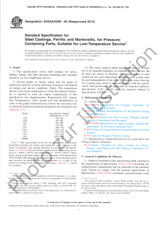Wir benötigen Ihre Einwilligung zur Verwendung der einzelnen Daten, damit Sie unter anderem Informationen zu Ihren Interessen einsehen können. Klicken Sie auf "OK", um Ihre Zustimmung zu erteilen.
ASTM D7750-23
Standard Test Method for Cure Behavior of Thermosetting Resins by Dynamic Mechanical Procedures using an Encapsulated Specimen Rheometer
Name übersetzen
NORM herausgegeben am 1.4.2023
Informationen über die Norm:
Bezeichnung normen: ASTM D7750-23
Ausgabedatum normen: 1.4.2023
SKU: NS-1143952
Zahl der Seiten: 8
Gewicht ca.: 24 g (0.05 Pfund)
Land: Amerikanische technische Norm
Kategorie: Technische Normen ASTM
Kategorie - ähnliche Normen:
Die Annotation des Normtextes ASTM D7750-23 :
Keywords:
complex viscosity, composites, cure behavior, dynamic property, flow, prepregs, rheological behavior, storage shear modulus, thermosetting resins, viscosity, viscous shear modulus,, ICS Number Code 83.080.10 (Thermosetting materials)
Ergänzende Informationen
| Significance and Use | ||||||||||||||||
|
5.1?This method provides a simple means of characterizing the cure behavior of a thermosetting resin specimen that is a representation of a composite part. The diameter of the specimen is approximately 38 mm and the thickness ranges from 2.6 mm to 3.2 mm. This corresponds to a sample volume of approximately 3 cm3 to 4 cm3. The data may be used for quality control, research and development, and verifying the cure within processing equipment including autoclaves. 5.2?Dynamic mechanical testing provides a sensitive method for determining cure characteristics by measuring the elastic and loss moduli as a function of temperature or time, or both. Plots of cure behavior and tan delta of a material provide graphical representation indicative of cure behavior under a specified time-temperature profile. The presence of fibers within the resin may change the dynamic properties measured within a material. However, it is still possible to compare different resins with the same fiber structure and obtain the relative difference due to the resin cure properties. 5.3?This method can be used to assess the following: 5.3.1?Cure behavior, as well as changes as a function of temperature or time, or both, 5.3.2?Processing behavior, as well as changes as a function of temperature or time, or both, 5.3.3?The effects of processing treatments, 5.3.4?Relative resin behavioral properties, including cure behavior, damping and impact resistance, 5.3.5?The effects of reinforcement on cure; the reinforcement can be a fiber or a filler, 5.3.6?The effects of materials used to bond the resin and reinforcement, 5.3.7?The effect of formulation additives that might affect processability or performance. 5.4?This provides a method to assess the cure properties of a thermosetting resin containing woven fiber or other reinforcing materials. 5.5?This method is valid for a wide range of oscillation frequencies typically from 0.002 Hz to 50 Hz. Note 1:?It is recommended that low-frequency test conditions,
generally 1 Hz to 2 Hz, be used to generate more definitive
cure-behavior information. Slower frequencies will miss important
cure properties. Faster frequencies will reduce sensitivity to
cure.
|
||||||||||||||||
| 1. Scope | ||||||||||||||||
|
1.1?This method covers the use of dynamic mechanical instrumentation for determination and reporting of the thermal advancement of cure behavior of thermosetting resin on an inert filler or fiber in a laboratory. It may also be used for determining the cure properties of resins without fillers or fibers. These encapsulated specimens are deformed in torsional shear using dynamic mechanical methods. 1.2?This method is intended to provide means for determining the cure behavior of thermosetting resins on fibers over a range of temperatures from room temperature to 250 ?C by forced-constant amplitude techniques (in accordance with Practice D4065). Plots of complex modulus, complex viscosity, and damping ratio or tan delta as a function of time or temperature, or both, quantify the thermal advancement or cure characteristics of a resin or a resin on filler or fiber. 1.3?Test data obtained by this method is relevant and appropriate for optimizing cure cycles. 1.4?The values stated in SI units are to be regarded as standard. No other units of measurement are included in this standard. 1.4.1?ExceptionThe Fahrenheit temperature measurement in 10.1 is provided for information only and is not considered standard. 1.5?This standard does not purport to address all of the safety concerns, if any, associated with its use. It is the responsibility of the user of this standard to establish appropriate safety, health, and environmental practices and determine the applicability of regulatory limitations prior to use. 1.6?This international standard was developed in accordance with internationally recognized principles on standardization established in the Decision on Principles for the Development of International Standards, Guides and Recommendations issued by the World Trade Organization Technical Barriers to Trade (TBT) Committee. |
||||||||||||||||
| 2. Referenced Documents | ||||||||||||||||
|
Empfehlungen:
Aktualisierung der technischen Normen
Wollen Sie sich sicher sein, dass Sie nur die gültigen technischen Normen verwenden?
Wir bieten Ihnen eine Lösung, die Ihnen eine Monatsübersicht über die Aktualität der von Ihnen angewandten Normen sicher stellt.
Brauchen Sie mehr Informationen? Sehen Sie sich diese Seite an.




 Cookies
Cookies
